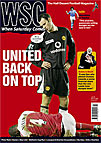 Half a century after moving into their rivals’ San Siro ground, Inter could be about to leave AC Milan’s terrible grass for pastures new. Matt Barker explains the thinking
Half a century after moving into their rivals’ San Siro ground, Inter could be about to leave AC Milan’s terrible grass for pastures new. Matt Barker explains the thinking
The two Milanese clubs have shared the Stadio Giuseppe Meazza, better known as the San Siro, since Inter moved in during the summer of 1948. The stadium, built in 1926, is frequently held up as a shining example of successful ground-sharing, yet both clubs regularly complain about the state of the pitch (replacement grass has to be flown in from Germany, though the proposed introduction of a synthetic pitch next year may solve the problem) and both are keenly aware of the potential long-term financial gains from having their own stadiums.
Like all Italian clubs, neither side actually owns the ground; instead, they pay €3.5 million (£2.4m) each in annual rent to the city council. The arrangement is a legacy of the fascist era (the council took charge of the ground in 1935), when teams were expected to function as true representatives of civic pride. In the past this has suited club chairmen just fine, but increasingly Internazionale owner Massimo Moratti and others believe going it alone makes more economic sense.
AC Milan themselves seem to be happy enough with life at the stadium (it is, after all, their original home), but Inter have other plans. Moratti commissioned Pirelli Real Estate (Pirelli are long-time sponsors of the nerazzurri shirts) to carry out an evaluation report on the stadium. The findings put the ground’s worth at around €30m (£20.7m), but Milan city hall was having none of it, putting the figure at closer to €150m.
Pirelli have now been asked to look into the costs of constructing a new ground, with Benfica’s Da Luz, built for Euro 2004, the preferred model. Moratti has been casting envious eyes towards the Premiership and was the main mover behind cross-club proposals to expand the San Siro along English lines. Plans for a 265-hectare “sports and leisure development” now look to have been shelved as the club find themselves increasingly at loggerheads with the council.
Building your own home costs money and Moratti will doubtless be hoping to strike some sort of sponsorship deal (Pirelli would be the obvious contender). January’s announcement that Italy is bidding to host the 2012 European Championship could also be a potential lifeline. Only one Italian stadium (actually the San Siro) is up to UEFA standards and the government are introducing generous tax breaks and credit facilities to help redevelop grounds.
Down in Rome, Lazio have already identified a site for their proposed new home, a scaled-down, all-seat complex with the backing of the capital’s police and fire departments. The problems at the unpopular Stadio delle Alpi in Turin are well known; the latest plan is for the stadium to be redeveloped and reduced to 40,000 seats by 2008. The clubs seem happy enough to carry on sharing (Torino left their Filadelfia home to move into Juve’s Stadio Comunale in 1960), but whether the brand-conscious and ambitious Juventus will want to stick with such an agreement forever remains to be seen.
If Inter do up and leave, the council will be anxious to ensure that Milan don’t follow suit. The rossoneri will be in a very strong position: the city won’t want to see its iconic stadium standing empty; the well connected football club could well end up buying out the council anyway.
The two sides meet in the league at the end of this month in what is a home game for Inter. Relations between the clubs – both on the curve and in the boardrooms – have always been relatively cordial. But mutual resentments simmer away in the background: on the one hand Inter command a larger fan base; but Milan have the greater trophy haul and enjoy the backing of Silvio Berlusconi. Breaking up the happy home may yet prove messy.
From WSC 217 March 2005. What was happening this month